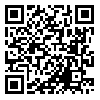Volume 14, Issue 1 (Winter 2025)
aumj 2025, 14(1): 49-58 |
Back to browse issues page
Ethics code: IR.GMU.REC.1400.145
Download citation:
BibTeX | RIS | EndNote | Medlars | ProCite | Reference Manager | RefWorks
Send citation to:



BibTeX | RIS | EndNote | Medlars | ProCite | Reference Manager | RefWorks
Send citation to:
Ziaee M, Ahmadi R, Khajavi A, Moadel A, Sharifi Mood F, Tavakolizadeh M. Prevalence and Pattern of Nosocomial Infections in a Hospital in North East of Iran during 2017-2021. aumj 2025; 14 (1) :49-58
URL: http://aums.abzums.ac.ir/article-1-1716-en.html
URL: http://aums.abzums.ac.ir/article-1-1716-en.html
Prevalence and Pattern of Nosocomial Infections in a Hospital in North East of Iran during 2017-2021
Maliheh Ziaee1 

 , Reza Ahmadi1
, Reza Ahmadi1 

 , Abdoljavad Khajavi1
, Abdoljavad Khajavi1 

 , Alireza Moadel1
, Alireza Moadel1 

 , Farnoosh Sharifi Mood1
, Farnoosh Sharifi Mood1 

 , Mitra Tavakolizadeh *2
, Mitra Tavakolizadeh *2 




 , Reza Ahmadi1
, Reza Ahmadi1 

 , Abdoljavad Khajavi1
, Abdoljavad Khajavi1 

 , Alireza Moadel1
, Alireza Moadel1 

 , Farnoosh Sharifi Mood1
, Farnoosh Sharifi Mood1 

 , Mitra Tavakolizadeh *2
, Mitra Tavakolizadeh *2 


1- Gonabad University of Medical Sciences, Gonabad, Iran
2- Gonabad University of Medical Sciences, Gonabad, Iran ,tavakolizadeh.m@gmu.ac.ir
2- Gonabad University of Medical Sciences, Gonabad, Iran ,
Abstract: (650 Views)
Background: Nosocomial infections represent a significant healthcare challenge worldwide, leading to increased treatment costs, extended hospital stays, and higher mortality rates. Effective control of these infections is essential for improving patient health and reducing healthcare expenses. This study aimed to determine the prevalence of nosocomial infections at a hospital in northeastern Iran from 2017 to 2021.
Methods: In this cross-sectional descriptive-analytical study, data were collected for 574 patients with nosocomial infections hospitalized in the selected hospital during the specified period. This information was extracted from the national nosocomial infection surveillance system and analyzed using SPSS v25 with appropriate statistical tests, considering a significance level of p<0.05.
Results: The overall prevalence of nosocomial infections during the study period was 0.76%. The mean age of affected patients was 60.25±34.37 years, with an average time of 14.67±28.32 days between admission and infection, and a mean length of stay of 29.02±31.15 days. Women represented 55.6% of the cases, with the highest prevalence recorded in 2021 at 36.7%. The most commonly identified pathogens were "Staphylococcus aureus" and "Escherichia coli". Tracheal tube and urine samples were the most frequently tested specimens.
Conclusion: The study highlights a higher prevalence of nosocomial infections in intensive care units and internal wards, particularly among patients with tracheal tubes and urinary catheters. These findings emphasize the need for implementing targeted preventive measures to mitigate the risk of nosocomial infections in hospital settings.
Methods: In this cross-sectional descriptive-analytical study, data were collected for 574 patients with nosocomial infections hospitalized in the selected hospital during the specified period. This information was extracted from the national nosocomial infection surveillance system and analyzed using SPSS v25 with appropriate statistical tests, considering a significance level of p<0.05.
Results: The overall prevalence of nosocomial infections during the study period was 0.76%. The mean age of affected patients was 60.25±34.37 years, with an average time of 14.67±28.32 days between admission and infection, and a mean length of stay of 29.02±31.15 days. Women represented 55.6% of the cases, with the highest prevalence recorded in 2021 at 36.7%. The most commonly identified pathogens were "Staphylococcus aureus" and "Escherichia coli". Tracheal tube and urine samples were the most frequently tested specimens.
Conclusion: The study highlights a higher prevalence of nosocomial infections in intensive care units and internal wards, particularly among patients with tracheal tubes and urinary catheters. These findings emphasize the need for implementing targeted preventive measures to mitigate the risk of nosocomial infections in hospital settings.
Keywords: Nosocomial Infections, Prevalence, Intensive Care Units, Staphylococcus aureus, Escherichia coli
Type of Study: Research |
Subject:
Special
Received: 2023/09/10 | Accepted: 2024/05/25 | Published: 2024/12/30
Received: 2023/09/10 | Accepted: 2024/05/25 | Published: 2024/12/30
Send email to the article author
| Rights and permissions | |
 |
This work is licensed under a Creative Commons Attribution-NonCommercial 4.0 International License. |



